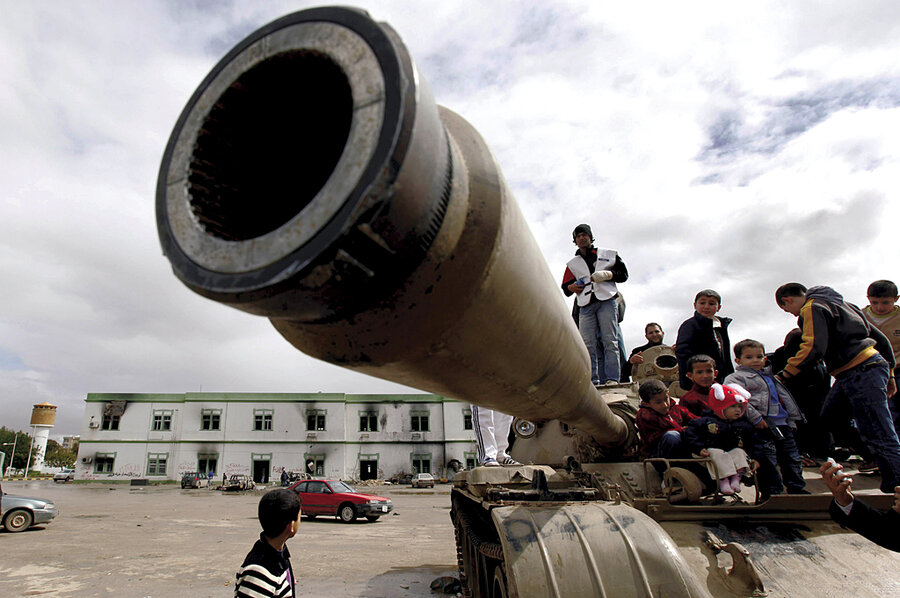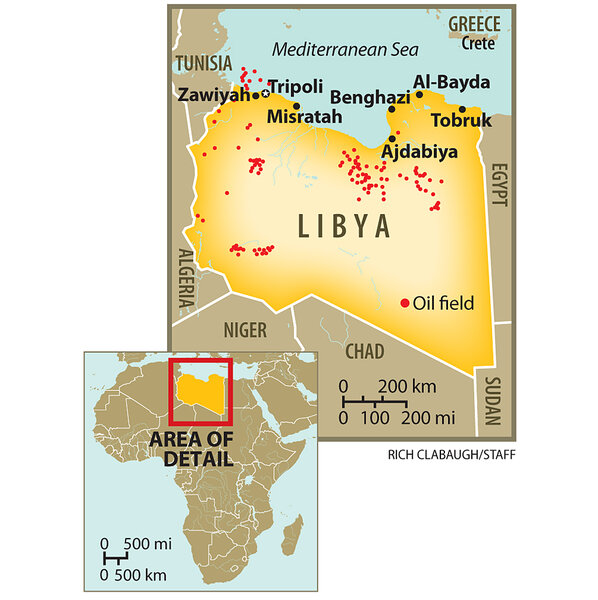How Qaddafi started losing Libya
Loading...
| Benghazi, Libya
The ruins of the sprawling military barracks in Benghazi, where a group of angry youths took on Libyan troops and won, will likely be remembered as the place where Muammar Qaddafi's downfall became inevitable.
Charred barracks and interrogation buildings, dozens of burned cars, and holes punched through the base's cement perimeter by backhoes and trucks tell the story of two fierce days of fighting that saw the bulk of Colonel Qaddafi's mixed force of foreign mercenaries and loyalists driven from Libya's second-largest city.
The rout of Qaddafi's supporters here on the Mediterranean, and the defections of almost every local Air Force and Army unit, certainly seems a harbinger of his downfall.
There were credible reports Friday that military bases at Tajura and Misratah, near the capital of Tripoli, had also defected. If true, the remainder of Qaddafi's 41-year reign will probably be measured in days.
The fall of Benghazi
Faraj al-Nafi was one of the young men in Benghazi who took up stones, Molotov cocktails, and homemade bombs against pro-Qaddafi forces and their heavy caliber weapons on the evening of Feb. 17. A week later, he explains how he had gotten a call from relatives in Benghazi saying that change – real change – was possible. After making the 40-mile trip from his small farming town, he was soon on the front lines.
"We had the feeling that if Benghazi fell, then the whole stinking house of cards would come down," says Mr. Nafi, helping to search for survivors in the charred hulk of Qaddafi's personal guesthouse on the base, where deep bunkers housed torture and interrogation centers. "And now we're very, very close."
Nafi describes chaos and explosions for hours on Feb. 17. Others fell around him. He was untouched, but is still shaken by the experience. He estimates about 200 members of the revolt fell here in two days of fighting, against 22 casualties for Qaddafi's forces. Nafi and others insist the Qaddafi loyalists were a blend of members of the feared Revolutionary Guard and poor mercenaries hired from places like Chad and Nigeria.
The fall of the Benghazi barracks and the liberation of the city by Feb. 20 – together with the entire eastern third of the country – wasn't due only to the bravery of young demonstrators. After an assault by the protesters on Qaddafi's guesthouse was held off by determined resistance, a unit of Libyan special forces mutinied and joined in.
It also appears that while the ranks of protesters were swelling with trained soldiers – and getting stronger themselves with weapons raided from arms dumps at the barracks and other parts of the city – a tactical retreat was called by Qaddafi as fighting broke out in Tripoli.
How Qaddafi braced for the storm
Col. Hussein al-Murfali, the head of the air wing at Benina Airfield on the outskirts of Benghazi, says it seems that Qaddafi knew a storm was coming. Early on Feb. 17, a Thursday, an order was sent to fly fighter planes and helicopters in Murfali's command to Sirte – Qaddafi's hometown and his second major stronghold after Tripoli.
Soon, members of the Revolutionary Guard (the "revolution" referring to is the 1969 coup led by Qaddafi and a few hundred soldiers) arrived to take small arms away from the base. The Air Force officers and men were then placed under armed guard and kept in a small set of offices for three days. "We were told if any of us came outside, we'd be shot," says the colonel.
He says many of the pilots who took off for Sirte instead diverted to eastern Libya and defected. On Friday, when a man arrived to tell Murfali that his remaining helicopters should start flying missions against demonstrators – he relayed the orders to his men, but with the proviso, "I wouldn't obey this order and suggest you do the same."
It was a dangerous moment; the day before, Revolutionary Guards had executed six officers who refused orders at the Benghazi barracks. "We knew about the officers at the barracks. But it wasn't really a choice," says Murfali. "We're supposed to obey orders. But orders to shoot our sons, our daughters, our family? No. There was no way any of us were going to do it."
He says two pilots who'd been dispatched from Benghazi to Sirte on Feb. 17 later ejected from their plane over the desert after receiving orders to strafe the resistance here.
In eastern Libya, fear of air power remains strong. But the Air Force officers here say those in the uprising shouldn't worry. "Sanctions, Qaddafi's own stupidity bled the force," says Col. Khalil Daraji, in charge of the base's helicopters. "Our planes are in bad condition and the pilots are with the people. Those pilots who ejected prove it. Qaddafi was losing Benghazi and he only had one plane to send."
How the barracks fell
The Benghazi barracks fell in the early morning of Sunday, as foreign mercenaries and Revolutionary Guards withdrew and made their way out of town – many to the airport.
Along the line of their retreat, apartment block walls are pockmarked from what residents say was indiscriminate fire from Qaddafi loyalists.
Anyone caught out in the street was shot, and about five area people were killed, says one resident who asked that his name not be used.
By midday Sunday, Daraji says, about 300 Qaddafi fighters were mustered on the tarmac, waiting for the civilian planes to fly them out to Sirte. He says the largest group of them was disarmed. He believed them to be foreigners – a detail borne out by folders they left behind in haste, which show photos of African men described as being from Nigeria and Chad.
A ring of armed men he took to be Revolutionary Guards surrounded them. Soon they were gone, and mixed units of Libyan soldiers and youths armed with rifles arrived. The airfield had fallen.
For the resistance now, it's "win or die," says Murfali, quoting Libyan hero Omar Mukhtar, who led a 20-year insurgency against Italian forces before being killed in 1931. "We know that we'll all be executed if this revolution fails, and we're not going to let that happen."






